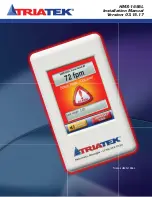
Due to continuous improvement, TRIATEK reserves the right to change product specifications without notice.
Pre-Installation
The HMS-1655L is calibrated and programmed in the factory
according to the customer specifications. Depending upon the actual
model number ordered, the HMS-1655L may be accompanied by one
or two sidewall sensors for measuring face velocity. The standard
sidewall sensor includes a 9-pin pluggable terminal block connector.
See page 14 for physical representations of the sidewall sensor.
Note: Final calibration of face velocity is usually required after
installation of the HMS-1655L.
Installation
This section will illustrate a typical method of installing the HMS-1655L
to a fume hood. Tools required include: drill, 3/8 drill bit, 1/8 drill bit,
Phillips #2 screwdriver, standard medium blade screwdriver, and
silicone sealant.
1. Proper location of the sensor is very important for the best
operation of the HMS-1655L. The system uses through-the-wall
sensing to measure the internal negative pressure of the fume
hood to accurately determine the face velocity. The sensor must
be located in a position that is least affected by turbulent air within
the hood. See illustration on page 13. There are two types of fume
hood arrangements which need to be considered; By-Pass and
Non-By-Pass.
a. Front-to-Back Position – With either type the sensor is
best located approximately six inches back from the
vertical sash track.
b. Vertical Position (By-Pass type) – Locate the sensor
vertically in the center of the region between the bottom of
the sash in it’s fully open position and the bottom edge of
the by-pass opening.
c. Vertical Position (Non-By-Pass type) – Locate the sensor
vertically six inches above the bottom of the sash in it’s
fully open position.
2. See page 13 for dimensions and suggested mounting
arrangements of the Triatek flow sensor on the hood wall.
3. Apply silicone sealant around the sensor immediately prior to
mounting the assembly to its mounting surface. Be sure to the
leave red cap on, being careful to avoid getting sealant in the
sensor port.
NOTE: Be certain that sensor reference port is in laboratory
room. If necessary to obtain this, use Triatek HMS-1655L-PLATE
mounted on exterior panel of the fume hood.
4. See page 10 for mounting details for the HMS-1655L display unit.
The preferred location is eye level, usually on one of the side
bezel panels. Please note that the display unit is cable-connected
to the control unit, and provisions must be made to route the cable
without interference with the hood sash or sash cable. The control
unit is typically placed in a convenient location on top of the fume
hood.
NOTE: Remove red cap from sensor after installation.
5. Connect the cable between the display and control unit before
applying power to the control unit. Power supply connections -
input voltage must be Class 2, 24 VAC or 24 VDC. An isolation
stepdown transformer is supplied with the HMS-1655L. Triatek
recommends that the HMS unit be powered using the supplied
transformer, and that only one unit be powered with each
transformer. Do not power any other device with the same
transformer.
6. For standard sidewall sensor modules with the 9-pin terminal
block, connect the 3-conductor signal cable as follows:
Sensor
|
Controller
Red: +Vin
►
+V
Black: GND
►
GND
Green: Vo
►
AI-1
7. All wiring should conform to the local regulations and the
National Electrical Code. Take care not to run sensor wiring in
the same conduit as line voltage or other conductors that supply
highly inductive loads such as generators, motors, solenoids or
contactors, etc. Use 22 AWG or larger.
8. After installation is complete, apply power to the unit, open the
sash to a normal operating position and observe the flow reading
on the HMS unit.
INSTALLATION
HMS-1655L
Triatek reserves the right to change product specifications without notice.
-
8
-
Pre-Installation and Installation























